RBSE Solutions for Class 7 Maths Chapter 5 Lines and Angles Ex 5.1
Rajasthan Board RBSE Solutions for Class 7 Maths Chapter 5 Lines and Angles Ex 5.1 Textbook Exercise Questions and Answers.
RBSE Class 7 Maths Solutions Chapter 5 Lines and Angles Ex 5.1
Question 1.
Find the complement of each of the following angles:
(i)

Answer:
Complement of 20° = 90° - 20° = 70°
(ii)

Answer:
Complement of 63° = 90° - 63° = 27°

(iii)
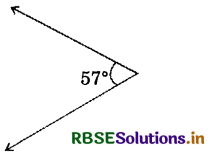
Answer:
Complement of 57° = 90° - 57° = 33°
Question 2.
Find the supplement of each of the following angles:
(i)
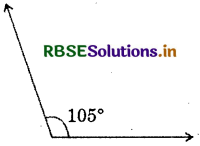
Answer:
Supplement of 105° = 180° - 105° = 75°
(ii)
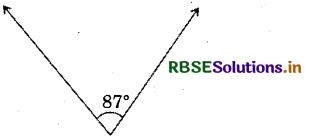
Answer:
Supplement of 87° = 180° - 87° = 93°
(iii)

Answer:
Supplement of 154° = 180° -154° = 26°

Question 3.
Identify, which of the following pairs of angles are complementary and which are supplementary?
(i) 65°, 115°
Answer:
∵ 65° + 115° = 180°
∴ Pair of angles 65°, 115° are supplementary.
(ii) 63°, 27°
Answer:
∵ 63° + 27° = 90°
∴ Pair of angles 63°, 21° are complementary.
(iii) 112°, 68°
Answer:
∵112° + 68° = 180°
∴ Pair of angles 112°, 68° are supplementary.
(iv) 130°, 50°
Answer:
∵ 130° + 50° = 180°
∴ Pair of angles 130°, 50° are supplementary.
(v) 45°, 45°
Answer:
∵ 45° + 45° = 90°
∴ Pair of angles 45% 45° are complementary.
(vi) 80°, 10°
Answer:
∵ 80° + 10° = 90°
∴ Pair of angles 80°, 10° are complementary.
Question 4.
Find the angle which is equal to its complement.
Answer:
Let the required angle be x.
Then, its complement = 90° - x
∵ The angle is equal to its complement.
∴ x = 90 - x
or x + x = 90
or 2x = 90
Dividing both sides by 2,
\(\frac{2 x}{2} \)= \(\frac{90}{2}\)
∴ x = 45°

Question 5.
Find the angle which is equal to its supplement.
Answer:
Let the required angle be x.
Then, its supplement = 180°
∵ Angle is equal to its supplement.
∴ x = 180° - x
or x + x = 180°
or 2x = 180°
Dividing both sides by 2,
\(\frac{2 x}{2}\) = \(\frac{180^{\circ}}{2}\)
or x = 90°
∴ Required angle is 90°.
Question 6.
In the given figure, ∠1 and ∠2 are supplementary angles. If ∠1 is decreased, what changes should take place in ∠2 so that both the angles still remain supplementary?
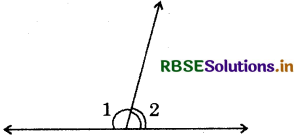
Answer:
If ∠1 decreases, then ∠2 should be increased by same amount of degree measure so that the both angles still remain supplementary.
Question 7.
Can two angles be supplementary if both of them are :
(i) acute?
Answer:
∵ Sum of two acute angles is always less than 180°.
∴ Two acute angles cannot be supplementary.
(ii) obtuse?
Answer:
∵ Sum of two obtuse angles is always greater than 180°.
∴ Two obtuse angles cannot be supplementary.
(iii) right?
Answer:
∵ Sum of two right angles is equal to 180°.
∴ Two right angles are supplementary.
Question 8.
An angle is greater than 45°. Is its complementary angle greater than 45° or equal to 45° or less than 45°?
Answer:
∵ Sum of two complementary angles is equal to 90°.
∴ Complementary angle of an angle greater than 45° is an angle less than 45°.

Question 9.
In the adjoining figure:
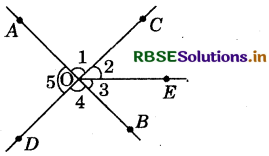
(i) Is ∠1 adjacent to ∠2?
Answer:
Yes, because ∠1 and ∠2 have common vertex, a common arm OC and non-common arms OA, OE are on either sides of common arm OC.
(ii) Is ∠AOC adjacent to ∠AOE
Answer:
No, because their non-common arms OC and OE are not the either sides of common arm OA.
(iii) Do ∠COE and ∠EOD form a linear pair?
Answer:
Yes, because ∠COE + ∠EOD = 180°.
(iv) Are ∠BOD and ∠DOA supplementary?
Answer:
Yes, because ∠BOD + ∠DOA = 180°.
(v) Is ∠1 vertically opposite to ∠4?
Answer:
Yes, because they are formed by two intersecting lines AB and CD with non-common arm.
(vi) What is the vertically opposite angle of ∠5?
Answer:
Vertically opposite angles of ∠5(AOD)
= ∠BOC = ∠2 + ∠3

Question 10.
Indicate, which pairs of angles are:
(i) Vertically opposite angles?
(ii) Linear pairs?
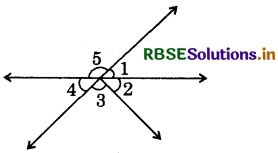
Answer:
(i) In the figure, following pairs are vertically opposite angles :
(a) ∠1 and ∠4
(b) (∠2 + ∠3) and ∠5
(ii) In the figure, following pairs are linear pairs:
(a) ∠1 and ∠5
(b) ∠1 and (∠2 + ∠3)
(c) (∠2 + ∠3) and ∠4
(d) ∠4 and ∠5
Question 11.
In the following figure, is ∠1 adjacent to ∠2? Give reasons.
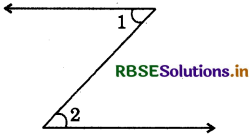
Answer:
No, ∠1 is not adjacent to ∠2 because they do not have a common vertex.
Question 12.
Find the value of the angles x, y and z in each of the following:

Answer:
∵ x and 55° are vertically opposite angles.
∴ x = 55°
Again, ∵ x and y from a linear pair.
∴ x + y = 180°
or 55° + y = 180°
or y = 180° - 55°
y = 125°
Also, ∵ z and y are vertically opposite angles.
∵ z = y
∴ z = 125°

(ii)
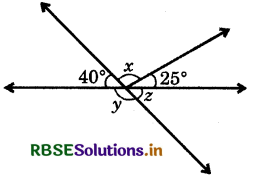
Answer:
∵ z and 40° are vertically opposite angles.
∴ z = 40°
Again, ∵ y and z from a linear pair.
y + z = 180°
or y + 40° = 180°
or y = 180° - 40°
∴ y = 140°
Also, ∵ (x + 25°) and y are vertically opposite angles.
∴ x + 25 - y
x + 25 = 140°
or x = 140° - 25°
∴ x = 115°
Question 13.
Fill in the blanks:
(i) If two angles are complementary, then the sum of their measures is ___________ .
Answer:
90°
(ii) If two angles are supplementary, then the sum of their measures is ___________ .
Answer:
180°
(iii) Two angles forming a linear pair are ______________ .
Answer:
supplementary
(iv) If two adjacent angles are supplementary, they form a ___________ .
Answer:
linear pair
(v) If two lines intersect at a point, then the vertically opposite angles are always ___________ .
Answer:
equal
(vi) If two lines intersect at a point, and if one pair of vertically opposite angles are acute angles, then the other pair of vertically opposite angles are ___________ .
Answer:
obtuse angles

Question 14.
In the adjoining figure, name the following pair of angles:
(i) Obtuse vertically opposite angles.
(ii) Adjacent complementary angles.
(iii) Equal supplementary angles.
(iv) Unequal supplementary angles.
(v) Adjacent angles that do not form a linear pair
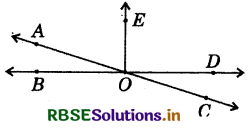
Answer:
(i) ∠AOD and ∠BOC are obtuse vertically opposite angles.
(ii) ∠AOB and ∠AOE are complementary adjacent angles.
(iii) ∠BOE and ∠EOD are equal supplementary angles.
(iv) Following pairs are of unequal supplementary angles:
(a) ∠AOB and ∠AOD
(b) ∠AOB and ∠BOC
(c) ∠BOC and ∠COD
(d) ∠COD and ∠AOD
(v) Following pairs are of adjacent angles that do not form a linear pair :
(a) ∠BOA and ∠AOE
(b) ∠AOE and ∠EOD
(c) ∠EOD and ∠DOC
